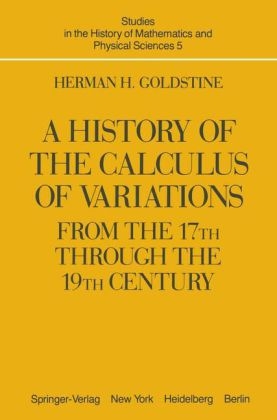
A Goldstine, H.H. A History of the Calculus of Variations from
Springer-Verlag New York Inc.
9780387905211 (ISBN)
- Titel ist leider vergriffen;
keine Neuauflage - Artikel merken
1. Fermat, Newton, Leibniz, and the Bernoullis.- 1.1. Fermat’s Principle of Least Time.- 1.2. Newton’s Problem of Motion in a Resisting Medium.- 1.3. The Brachystochrone Problem.- 1.4. The Problem Itself.- 1.5. Newton’s Solution of the Brachystochrone Problem.- 1.6. Leibniz’s Solution of the Brachystochrone Problem.- 1.7. John Bernoulli’s First Published Solution and Some Related Work.- 1.8. James Bernoulli’s Solution.- 1.9. James Bernoulli’s Challenge to His Brother.- 1.10. James Bernoulli’s Method.- 1.11. John Bernoulli’s 1718 Paper.- 2. Euler.- 2.1. Introduction.- 2.2. The Simplest Problems.- 2.3. More General Problems.- 2.4. Invariance Questions.- 2.5. Isoperimetric Problems.- 2.6. Isoperimetric Problems, Continuation.- 2.7. The Principle of Least Action.- 2.8. Maupertuis on Least Action.- 3. Lagrange and Legendre.- 3.1. Lagrange’s First Letter to Euler.- 3.2. Lagrange’s First Paper.- 3.3. Lagrange’s Second Paper.- 3.4. Legendre’s Analysis of the Second Variation.- 3.5. Excursus.- 3.6. The Euler-Lagrange Multiplier Rule.- 4. Jacobi and His School.- 4.1. Excursus.- 4.2. Jacobi’s Paper of 1836.- 4.3. Excursus on Planetary Motion.- 4.4. V.-A. Lebesgue’s Proof.- 4.5. Hamilton-Jacobi Theory.- 4.6. Hesse’s Commentary.- 5. Weierstrass.- 5.1. Weierstrass’s Lectures.- 5.2. The Formulation of the Parametric Problem.- 5.3. The Second Variation.- 5.4. Conjugate Points.- 5.5. Necessary Conditions and Sufficient Conditions.- 5.6. Geometrical Considerations of Conjugate Points.- 5.7. The Weierstrass Condition.- 5.8. Sufficiency Arguments.- 5.9. The Isoperimetric Problem.- 5.10. Sufficient Conditions.- 5.11. Scheeffer’s Results.- 5.12. Schwarz’s Proof of the Jacobi Condition.- 5.13. Osgood’s Summary.- 6. Clebsch, Mayer, and Others.- 6.1. Introduction.- 6.2. Clebsch’s Treatment of the Second Variation.- 6.3. Clebsch, Continuation.- 6.4. Mayer’s Contributions.- 6.5. Lagrange’s Multiplier Rule.- 6.6. Excursus on the Fundamental Lemma and on Isoperimetric Problems.- 6.7. The Problem of Mayer.- 7. Hilbert, Kneser, and Others.- 7.1. Hilbert’s Invariant Integral.- 7.2. Existence of a Field.- 7.3. Hibert, Continuation.- 7.4. Mayer Families of Extremals.- 7.5. Kneser’s Methods.- 7.6. Kneser on Focal Points and Transversality.- 7.7. Bliss’s Work on Problems in Three Space.- 7.8. Boundary-Value Methods.- 7.9. Hilbert’s Existence Theorem.- 7.10. Bolza and the Problem of Bolza.- 7.11. Carathéodory’s Method.- 7.12. Hahn on Abnormality.
| Verlagsort | New York, NY |
|---|---|
| Sprache | englisch |
| Themenwelt | Mathematik / Informatik ► Mathematik ► Allgemeines / Lexika |
| Mathematik / Informatik ► Mathematik ► Analysis | |
| ISBN-13 | 9780387905211 / 9780387905211 |
| Zustand | Neuware |
| Informationen gemäß Produktsicherheitsverordnung (GPSR) | |
| Haben Sie eine Frage zum Produkt? |
aus dem Bereich


